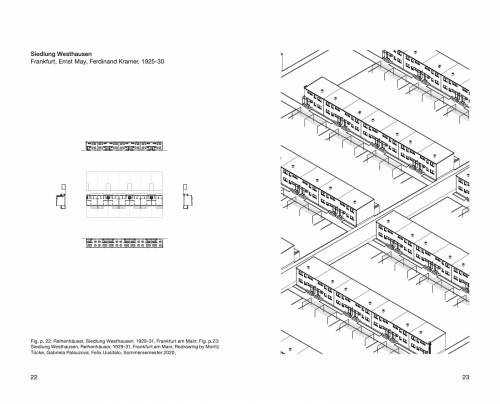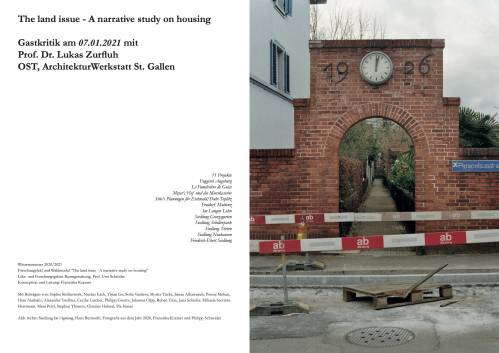„Damit ist auch das richtige getroffen, denn in technischer Beziehung wurde tatsächlich viel, in künstlerischer aber fast nichts geleistet und stehen die großartigsten neuen Monumentalbauten meist ungeschickten Platzformationen und Parzellierungen der Nachbarschaft gegenüber.“ [Sitte, Camillo, Der Städtebau nach seinen künstlerischen Grundsätzen, Wien, 1909]
A scientific discourse
The Swiss architect and urban planner Hans Bernoulli publishes in 1946 the book Die Stadt und ihr Boden. In the introduction he refers to the important writings of Le Corbusier (Städtebau), Raymond Unwin (Die Grundlagen des Städtebaus) and Cornelius Gurlitt (Handbuch des Städtebau). But, according to Bernoulli, the essential question has not been bespoken in one of the publications: the land on which all the beautiful and good designs can become an architectural being. The young man who reads the books has become doubtful: „there must be something wrong with the land“, he stated.
To follow the property question, Hans Bernoulli publishes numerous articles and writings regarding the land issue, with the aim to claim for the return of the land to the public authorities. Only this procedure, he is convinced, would lead to a beautiful and good architecture. Whoever writes about Stadtbaukunst ignores one question, the prerequisite of all work, the land property, he says. Bernoulli follows this topic under the pressure of the seriousness of the situation, (Bernoulli means the reconstruction of the cities after WWII) and therefore his book can be understood as a research about the land issue by analysing historical, political and formal conditions in landscapes and cities. According to Bernoulli, the property question is the essential subject for understanding transformation processes in urban planning.
Hans Bernoulli‘s formal position arose at the beginning of his education as an architect in an environment of teachers, who referred to Camillo Sitte‘s artistic principles in urban planning at southern German Universities, such as Theodor Fischer, Friedrich Pützer and others. The publication Der Städtebau nach seinen künstlerischen Grundsätzen from 1889 has been a key-literature for Bernoulli‘s teachers regarding the meaning of public spaces and their composition. An underestimated part of the book deals with the controversial debate in urban planning on infrastructure and hygenic conditions. Sitte speaks about the important role of a good parcellation for urban planning
Sitte‘s publication from 1889 can be seen as the starting point of a controversial discussion about the land issue. Hans Bernoulli‘s publication can be understood somehow as the end of a discussion by pointing on the ambiguous relation of the land issue and compository questions in architecture and a problem that has not been solved, yet.
Research seminar
Building upon the precise analysis of the different theories, the research seminar The land issue. A narrative study on housing will examine the built work of selected architects and urban planners with the aim to create a catalogue of housing projects and to explore the land issue‘s influence on parcellation layouts and spatial composition.The seminar‘s argumentation follows Bernoulli‘s thesis and tries to evaluate in which way the relationship between the land issue, the plot and the spatial composition can be described.
Descriptive analysis
The research seminar‘s aim is to analyse the relationship between plot and housing. The research questions that will have to be answered are: In which way did the discourse on the land issue influenced the selected projects? Which idea of city and space is represented by the projects? We will ask and figure out in which way the design process can be described and represented by words and drawings. The individual storyboard of each project can be related to the following keywords and topics: Cultural-History; Politics; The land issue; property questions; standardisation and building methods; typological questions; administrative background; the role of the architect; space, form and composition. The descriptive analysis includes written expressions as well as pictures, plans and redrawings, which should be curated precisely and retell the story of the project through the lense of the land issue.
Information
Das erste Meeting wird am 29.10.2020 um 14:00 Uhr via Zoom stattfinden. Bitte kontaktieren Sie mich direkt bei Fragen zu dem Forschungsmodul oder dem Wahlfach via Mail. Wenn Sie keinen Platz über das Wahlverfahren zugelost bekommen haben und dennoch teilnehmen möchten, melden Sie sich bitte ebenfalls per Mail.
Module: The land issue - A narrative study on housing
Module Code: 20.00104 [Forschungsfeld], 21.00024 [Wahlfach]
Semester: WS
Jahr: 2020/21
Mitarbeit: Franziska Kramer
Tutoren: Valentin Burkhardt, Franka Bienstein
Projekte: ARCHEA, Dissertation: City and Plot
Schriften: Stadt der Räume. Interdisziplinäre Überlegungen zu Räumen der Stadt, Horror vacui. Über die Räume der Stadt, Die Idee der Stadt / L’idea della città, Pardié. Konzept für eine Stadt nach dem Zeitregime der Moderne, Architektur. Raum. Theorie. Eine kommentierte Anthologie
Module: DIE PARZELLE - unsichtbare Grenze der Stadt, DIE PARZELLE 2 - Typologie, The land issue. Theories and models of housing, Forschungsfeld M.Sc._On boundaries – A narrative study on plots, Wahlfach B.Sc., On boundaries – A study on thresholds, Forschungsfeld M.Sc. – FORMEN DES EXISTIERENDEN – Zwei Bauten des Architekten Saverio Muratori. La chiesa Parrocchiale ”S. Giovanni al Gatano” e l’edificio in ”Largo Spartaco”.



